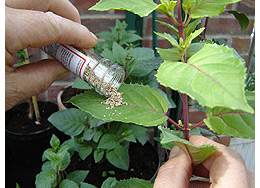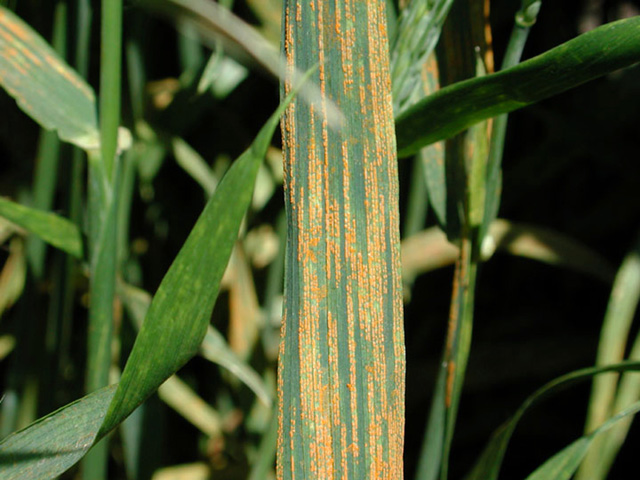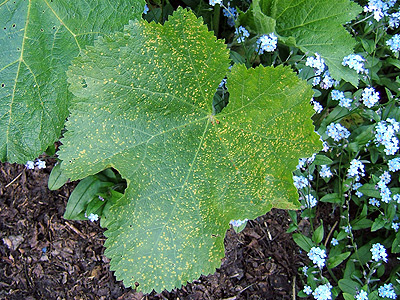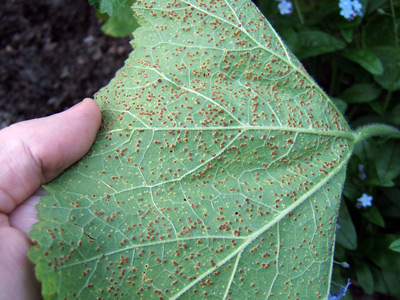Rust - plant fungal disease
Signs - Looks like the plant is going rusty (very descriptive these fungal diseases). Orange-brown pustules develop initially on the undersides of leaves. These may be unnoticed for some time, so by the time the pustules appear on the upper leaf surface and are noticed, the disease has taken hold. As with many fungal diseases that affect plant leaves, rust is not a particular disease but can be caused by any one of a whole group of different fungi. Different fungal species often have different host preferences and life cycles.
Damage - Not usually a direct killer, but very unsightly and will affect growth, flowering and fruiting, badly affected plants can be so weakened they are unable to withstand winter frosts.
Treatment - A fungal disease so one of the best ways of dealing with it is by good hygiene. Remove all dead leaves in autumn to prevent the spores from over wintering, burn the leaves or take them to the skip rather than use them for compost or you may well just perpetuate the problem.
Grow resistant varieties. Badly infected plants are best discarded - on the bonfire or tip - not the garden compost heap - and replaced.
Improve ventilation for plants grown under cover. Keep plants watered and fed well so they are able to fend off the effects of rust with their own immune system.
Hollyhocks will almost always get rust, you could deal with it by growing new plants each year, or as I do, by letting them self-seed, so selecting out the more resistant genes and then removing the worst affected leaves from the bottom of the stems and removing them from the garden. The leaves don't need to be removed until they are obviously on their way out.
Horsetail tea - to control fungus
Horsetail (Equisetum arvense) is a pernicious weed which spreads by underground stems that go very deep and form horizontal rhizome systems. This makes it particularly difficult to control particularly on heavy soils where trying to pull it up just breaks off the stems leaving a piece in the soil to carry on.
If you have a horsetail problem, there's a bright side to
it because an infusion of the weed makes a good fungicide for
control of mildew on strawberries and other crops, and
checks rust on celery and celeriac.
Collect the horsetail, foliage, stems, rhizomes and all, and
for each 28g (1oz) pour on 1.1 Litres (2pt) hot, not boiling,
water, and allow to stand for twenty-four hours. Strain off
the 'tea' and use undiluted.
Convalescence care - Plant diseases are often difficult to address directly, but you can help your plants get through an illness with some pampering and attention:
1 - Clear the base of any other plants, loosen any tight ties and add mulch. Make a circle of bare soil around the base of the trunk to at least a radius of 30cm (1ft), cover this with a thick layer of mulch, though don't pile it up against the trunk so it can "breathe".
2 - Give the plant a feed, a full watering cans worth, 10L or 2 gallons of suitably diluted liquid feed.
3 - Water regularly if there's no rain, a full watering cans worth once a week if it doesn't rain or if there's only a sprinkle. NOT if the soil is already damp though.
4 - Trim other nearby plants, it may be that your plant is struggling in the shadow of other larger plants and isn't getting enough light to build its strength, which plant do you want the most?

Insect
hotel / house
A sheltered insect house to help a range of beneficial
insects to over-winter in your garden. If they are over-wintering there,
they are in an ideal position come the spring and summer to wake up and
help to combat any pests you may have. Amongst others, good for ladybirds,
lacewings and solitary wasps which will help keep your unwanted garden visitors
down. Place in a sheltered place outdoors.

Biological
Pest Control - Organic living pest control for a variety of
problems, red spider mite, whitefly, fungus gnats (sciarid fly), thrips, mealy bug,
vine weevils and more.
These are parasites or predators that will specifically infect the pest they are brought in to control without harming any other living things and without the use of chemicals. A small population of pests needs to be maintained so that the control agent doesn't die out.

Chemical insecticides - If your plants get a heavy infestation, then I think it's acceptable to use a chemical insecticide as a "smart missile" just on that particular plant. I resort to this when the aphids build up under cover on my favourite plum tree, or other plant/s. Don't overdo it and spray too often and don't spray the whole garden "just-in-case", buy a small 1L or thereabouts sprayer so you don't get carried away.
Not pest specific.
Copyright 2000 - present. All Rights Reserved | Privacy Policy Statement



